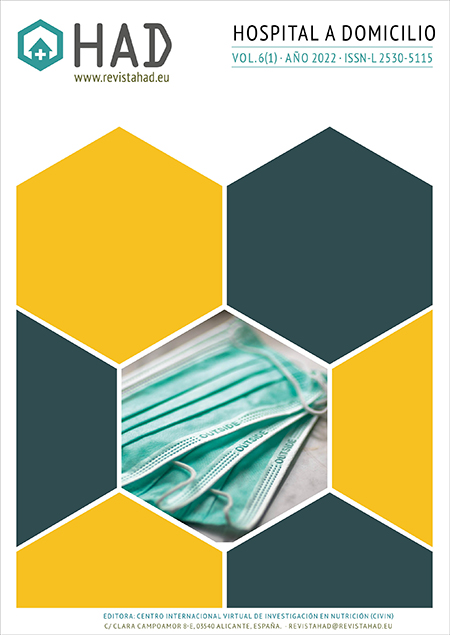Estudio epidemiológico de la prevalencia del síndrome de intestino corto en España
DOI:
https://doi.org/10.22585/hospdomic.v6i1.152Palabras clave:
Síndrome del Intestino Corto, Nutrición Parenteral en el Domicilio, Epidemiología, Prevalencia, Servicios de Atención de Salud a DomicilioResumen
Introducción: El síndrome de intestino corto (SIC) es una alteración de la absorción de los nutrientes causado, frecuentemente, por la resección quirúrgica del intestino delgado. El espectro de las manifestaciones clínicas varía ampliamente, según la longitud remanente del intestino delgado.
Objetivo: Conocer la prevalencia de los casos de SIC en España en el año 2018.
Método: Estudio observacional transversal multicéntrico, de base poblacional, mediante cuestionario telemático en el que se recogen los datos de los pacientes diagnosticados de SIC en 2018.
Resultados: De un total de 541 centros sanitarios seleccionados, del Catálogo Nacional de Hospitales del Ministerio de Sanidad, participaron 101 hospitales. Con los datos obtenidos, la prevalencia de SIC en España se estimaría en 4,18 pacientes por millón de habitantes durante ese año.
Conclusiones: La falta de participación dificulta obtener resultados concluyentes, lo que resulta mucho más importante cuando se trata de problemas de salud poco prevalentes.
Descargas
Citas
O’Keefe SJ, Buchman AL, Fishbein TM, Jeejeebhoy KN, Jeppesen PB, Shaffer J. Short bowel syndrome and intestinal failure: consensus definitions and overview. Clin Gastroenterol Hepatol. 2006;4(1):6-10. DOI: 10.1016/j.cgh.2005.10.002
Carbonnel F, Cosnes J, Chevret S, Beaugerie L, Ngô Y, Malafosse M, et al. The role of anatomic factors in nutritional autonomy after extensive small bowel resection. JPEN J Parenter Enteral Nutr. 1996;20(4):275–80. DOI: 10.1177/0148607196020004275
Nightingale JM, Lennard-Jones JE. The short bowel syndrome: what’s new and old? Dig Dis. 1993;11(1):12-31. DOI: 10.1159/000171397
Mullady DK, O’Keefe SJ. Treatment of intestinal failure: home parenteral nutrition. Nat Clin Pract Gastroenterol Hepatol. 2006;3(9):492–504. DOI: 10.1038/ncpgasthep0580
Nightingale J, Woodward JM, Gastroenterology SBaNCotBSo. Guidelines for management of patients with a short bowel. Gut. 2006;55(Suppl 4):1–12. DOI: 10.1136/gut.2006.091108
Carroll RE, Benedetti E, Schowalter JP, Buchman AL. Management and Complications of Short Bowel Syndrome: An Updated Review. Curr Gastroenterol Rep. 2016;18(7):e40. DOI: 10.1007/s11894-016-0511-3
Pironi L, Goulet O, Buchman A, Messing B, Gabe S, Candusso M et al. Outcome on home parenteral nutrition for benign intestinal failure: a review of the literature and benchmarking with the European prospective survey of ESPEN. Clin Nutr. 2012;31(6):831-45. DOI: 10.1016/j.clnu.2012.05.004
Higuera I, García-Peris P, Camblor M, Bretón I, Velasco C, Romero R, et al. Outcomes of a general hospital-based home parenteral nutrition (HPN) program; report of our experience from a 26-year period. Nutr Hosp. 2014;30(2):359–65. DOI: 10.3305/nh.2014.30.2.7592
Howard L. Home parenteral nutrition: survival, cost, and quality of life. Gastroenterology. 2006;130(Suppl 2):S52-9. DOI: 10.1053/j.gastro.2005.09.065
Fundación Instituto para el Desarrollo e Integración de la Sanidad (IDIS). Informe Sanidad Privada: Aportando Valor. Análisis de situación 2014 [Internet]. Madrid, España: IDIS; 2014 [consultado 5 noviembre de 2021]. Disponible en: https://bit.ly/3pyEgyt
Instituto Nacional de Estadística (INE). INEBASE (sede Web). Madrid, España: INE; 2016 [consultada 5 noviembre de 2021]. Disponible en: https://bit.ly/3Es1pGX
Buchman AL, Scolapio J, Fryer J. AGA technical review on short bowel syndrome and intestinal transplantation. Gastroenterology. 2003;124(4):1111–34. DOI: 10.1016/s0016-5085(03)70064-x
Wanden-Berghe C, Virgili Casas N, Cuerda Compes C, Ramos Boluda E, Pereira Cunill JL, Maiz Jiménez MI, et al.; Grupo NADYA-SENPE. Nutrición parenteral domiciliaria en España, 2019: informe del Grupo de Nutrición Artificial Domiciliaria y Ambulatoria NADYA. Nutr Hosp. 2021;38(6):1304-9. DOI: 10.20960/nh.03720
DiBaise JK, Young RJ, Vanderhoof JA. Intestinal rehabilitation and the short bowel syndrome: part 1. Am J Gastroenterol. 2004;99(7):1386–95. DOI: 10.1111/j.1572-0241.2004.30345.x
Jeppesen PB. Teduglutide, a novel glucagon-like peptide 2, in the treatment of patients with short bowel syndrome. Therap Adv Gatroenterol. 2012;5(3):159-71. DOI: 10.1177/1756283X11436318
González Aguilera B, Olveira G, García-Luna PP, Pereira Cunill JL, Luengo LM, Pérez de la Cruz A, Irles Rocamora JA. Documento de Consenso de expertos de Andalucía y Extremadura sobre la nutrición parenteral domiciliaria. Nutr Hosp. 2017;34(4):784-91. DOI: 10.20960/nh.881
von Websky MW, Liermann U, Buchholz BM, Kitamura K, Pascher A, Lamprecht G, et al. Short bowel Syndrome in Germany: Estimated prevalence and standard of care. Chirurg. 2014;85(5):433-9. DOI: 10.1007/s00104-013-2605-x
Instituto de Salud Carlos III (ISCIII). Portal de registro de enfermedades raras [Internet]. Madrid, España: ISCIII; [consultado 12 diciembre 2021]. Disponible en: https://bit.ly/3qqxKZt
Nightingale JM, Lennard-Jones JE, Gertner DJ, Wood SR, Bartram CI. Colonic preservation reduces need for parenteral therapy, increases incidence of renal stones, but does not change high prevalence of gall stones in patients with a short bowel. Gut. 1992;33(11):1493–7. DOI: 10.1136/gut.33.11.1493
Underhill BM. Intestinal length in man. Br Med J. 1955;19:2(4950):1243-6. DOI: 10.1136/bmj.2.4950.1243
Pironi L, Steiger E, Joly F, Jeppesen PB, Wanten G, Sasdelli AS, et al. Characteristics of adult patients wirh chronic intestinal failure due to short bowel syndrome: An international multicenter survey. Clin Nutr ESPEN. 2021;45:433-44. DOI: 10.1016/clnesp.2021.07.004
Neelis EG, Roskott AM, Dijkstra G, Wanten GJ, Serlie MJ, Tabbers MM, et al. Presentation of a nationwide multicenter registry of intestinal failure and intestinal transplantion. Clin Nutr. 2016;35(1):225-9. DOI: 10.1016/clnu.2015.01.010
Diamanti A, Capriati T, Gandullia P, Di Leo G, Lezo A, Lacitignola L, et al. Pediatric Chronic Intestinal Failure in Italy: Report from the 2016 Survey on Behalf of Italian Society for Gastroenterology, Hepatology and Nutrition (SIGENP). Nutrients. 2017;9(11):1217. DOI: 10.3390/nu9111217
Wiskin AE, Russell R, Barclay AR, Thomas J, Batra A; BANS committee of BAPEN. Prevalence of home parenteral nutrition in children. Clin Nutr ESPEN. 2021;42:138-41. DOI: 10.1016/J.CLNESP.2020.12.029
Descargas
Publicado
Cómo citar
Número
Sección
Licencia
Derechos de autor 2022 Carmina Wanden-Berghe Lozano, Vanessa E. Oller-Arlandis, Andrea Domingo-Pueyo

Esta obra está bajo una licencia internacional Creative Commons Atribución-NoComercial-CompartirIgual 4.0.
Aquellos autores/as que tengan publicaciones con esta revista, aceptan los términos siguientes:
- Los autores/as conservarán sus derechos de autor y garantizarán a la revista el derecho de primera publicación de su obra, el cuál estará simultáneamente sujeto a la Licencia de reconocimiento de Creative Commons 4.0 BY-NC-SA que permite a terceros compartir la obra siempre que se indique su autor y su primera publicación esta revista.
- Los autores/as podrán adoptar otros acuerdos de licencia no exclusiva de distribución de la versión de la obra publicada (p. ej.: depositarla en un archivo telemático institucional o publicarla en un volumen monográfico) siempre que se indique la publicación inicial en esta revista.
- Se permite y recomienda a los autores/as difundir su obra a través de Internet (p. ej.: en archivos telemáticos institucionales o en su página web) antes y durante el proceso de envío, lo cual puede producir intercambios interesantes y aumentar las citas de la obra publicada. (Véase El efecto del acceso abierto).







